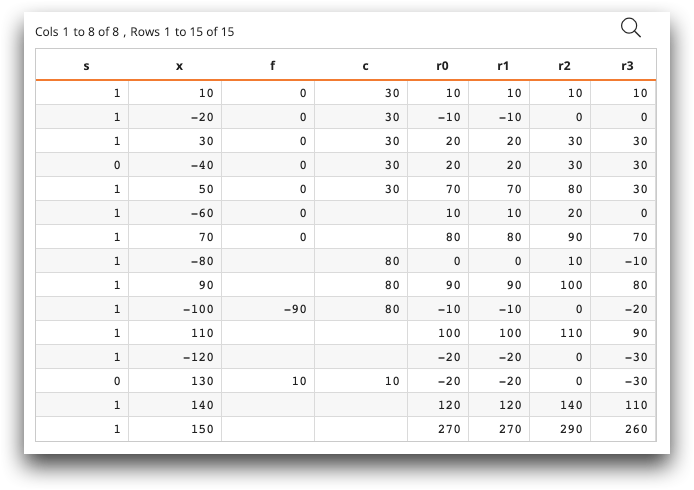g_cumsum_clamp(G;S;O;X;F;C)
Returns the cumulative sum within a given group, "clamping" it so that it is never less than or greater than a given value.
Function type
Vector only
Syntax
g_cumsum_clamp(G;S;O;X;F;C)
Input
| Argument | Type | Description |
|---|---|---|
G |
any | A space- or comma-separated list of column names Rows are in the same group
if their values for all of the columns listed in If If any of the columns listed in |
S |
integer | The name of a column in which every row evaluates to a 1 or 0, which determines
whether or not that row is selected to be included in the calculation If
If any of the values in
|
O |
integer | A space- or comma-separated list of column names that
determine the row order within a particular group If
If any of the values in |
X |
integer or decimal | A column name An N/A in |
F |
integer or decimal | An optional value indicating the mimimum
value (floor) at each new row. If you use a column or expression, the floor can vary from row to row. An N/A in |
C |
integer or decimal | An optional value indicating the maximum
value (ceiling) at each new row. If you use a column or expression, the ceiling can vary from row to row. An N/A in |
Return Value
For every row in each group defined by G and ordered by O (and
for those rows where S=1, if
specified), g_cumsum_clamp returns a decimal number
corresponding to the sum of X for all rows up to
and including that row, with a floor value of F and
a ceiling value of C.
If no rows in a group have valid (non-N/A) values for X, the result for
every row of the group is 0.
Sample Usage
<base table="pub.doc.samples.ref.func.g_func_time_series_sample_usage"/> <willbe name="g_cumsum_1" value="g_cumsum(state;include;order;value)"/> <willbe name="g_cumsum_2" value="g_cumsum(state city;include;order;value)"/> <willbe name="g_cumsum_clamp" value="g_cumsum_clamp(state;include;order;value;5;20)"/>

Example
<table cols="s,x,f,c">
1,10,0,30;1,-20,0,30;1,30,0,30;0,-40,0,30;1,50,0,30;
1,-60,0,;1,70,0,;1,-80,,80;1,90,,80;1,-100,-90,80;
1,110,,;1,-120,,;0,130,10,10;1,140,,;1,150,,;
</table>
<!-- note 0 selection argument rows 4,13 -->
<willbe name="r0" value="g_cumsum(;s;;x)"/>
<!-- no clamp, same as cumsum -->
<willbe name="r1" value="g_cumsum_clamp(;s;;x;;)"/>
<!-- constant floor only -->
<willbe name="r2" value="g_cumsum_clamp(;s;;x;0;)"/>
<!-- varying floor and ceiling -->
<willbe name="r3" value="g_cumsum_clamp(;s;;x;f;c)"/>
